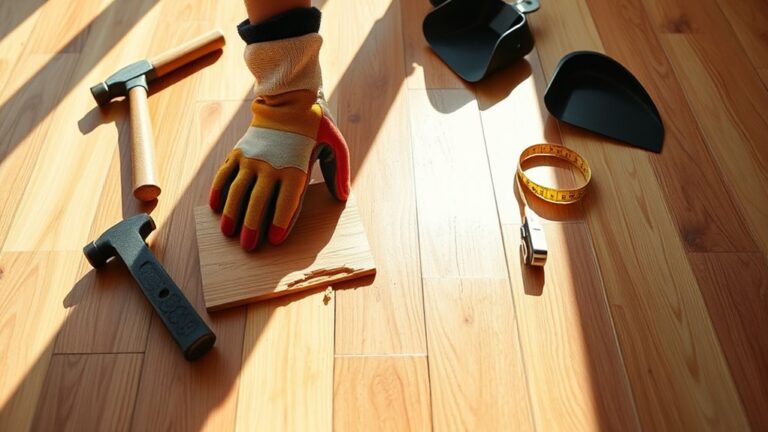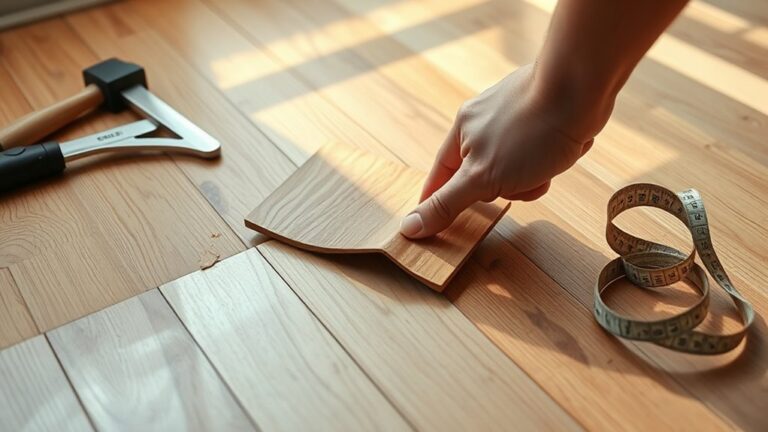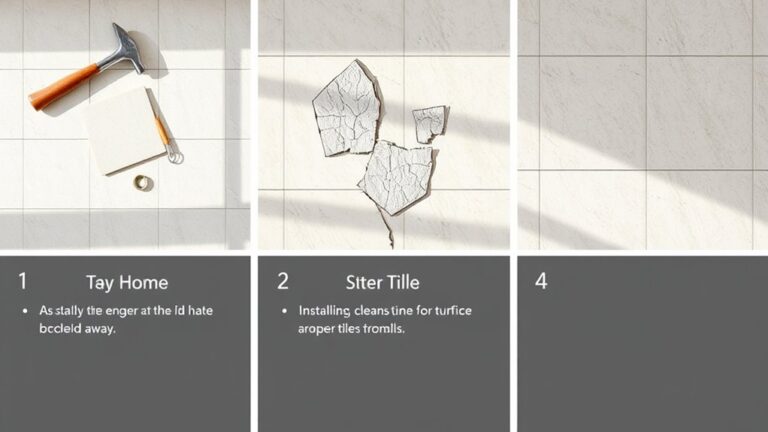Common problems with tile floors include loose tiles from improper installation, which often results from inadequate adhesive coverage or an uneven subfloor. Neglecting maintenance can lead to dirty grout lines and unpleasant odors, while inappropriate adhesive selection can compromise durability. You might also encounter stains in kitchens due to spills or greasy buildup. Regular inspections help catch issues early, preventing costly repairs. Addressing visible signs like cracks or discoloration promptly is essential. Want to avoid these headaches? There are effective techniques and tips to guarantee your tile floors remain beautiful and durable for years to come.
Loose Tiles From Improper Installation
When it comes to tile floors, loose tiles can be a frustrating issue, often stemming from improper installation. One of the primary culprits is inadequate adhesive coverage. For residential settings, the adhesive should cover at least 80% of the tile surface to guarantee a strong bond. Without this, tiles are more likely to shift and loosen over time.
Another vital factor is the condition of your subfloor. If it's not flat and solid, any dips or bumps can create stress points that lead to loose tiles. Before installation, make certain your subfloor is level; this simple step can prevent future issues.
Proper spacing between tiles also plays a significant role. Insufficient grout joints can allow for movement, making it easier for tiles to loosen. It's important to maintain consistent spacing during installation to promote stability.
Additionally, using the correct type of adhesive for your specific tile material and environment is imperative. An improper choice can weaken the bond, increasing the likelihood of loose tiles.
To avoid the frustration of loose tiles, focus on proper installation techniques from the start. Regular monitoring and maintenance are also necessary. Keeping an eye on your tiles can help catch issues early, preventing larger problems like cracking or water damage. By taking these steps, you'll guarantee your tile floors remain beautiful and secure for years to come.
Maintenance Neglect and Its Consequences
Neglecting regular maintenance on tile floors can lead to a host of problems that compromise both their appearance and structural integrity. When you overlook cleaning, dirt, soap scum, and mildew can accumulate, diminishing the aesthetic appeal of your tiles and posing potential health risks due to mold growth. Additionally, maintenance neglect often extends to grout lines. Since grout is porous, it easily absorbs liquids, leading to stains, discoloration, and unpleasant odors that are tough to remove.
Water exposure is another significant consequence of inadequate maintenance. If moisture is trapped beneath the tiles, it can cause substantial damage, including expansion, cracking, and, ultimately, mold growth under the surface. Regular inspections are essential; visible signs of water damage can indicate deeper issues requiring immediate attention to prevent costly repairs down the line.
You don't want to find yourself facing premature wear and tear due to lack of upkeep. A consistent maintenance routine not only prolongs the lifespan of your tile flooring but also saves you money on unnecessary replacements. Simple steps such as regular sweeping, mopping, and sealing grout lines can make a world of difference. By prioritizing maintenance, you guarantee that your tile floors remain not just beautiful but also structurally sound, allowing you to enjoy the freedom of a well-kept living space.
Inappropriate Adhesive Selection
Even with diligent maintenance, improper adhesive selection can undermine the integrity of your tile floors. Choosing the wrong adhesive not only leads to grout cracking and loose tiles but also compromises the overall durability and longevity of your installation. For instance, if you use a standard adhesive in high-moisture areas like bathrooms, you risk adhesive breakdown and potential water damage beneath the tiles.
To help you navigate the complexities of adhesive selection, consider the following table:
| Tile Material | Recommended Adhesive | Common Issues with Inappropriate Selection |
|---|---|---|
| Ceramic Tiles | Thin-set Mortar | Grout cracking, loose tiles |
| Natural Stone | Epoxy Adhesive | Nonbonding, possible water damage |
| Vinyl Tiles | Pressure-Sensitive Adhesive | Buckling, peeling |
| Porcelain Tiles | Modified Thin-set Mortar | Installation issues, reduced durability |
Always follow the manufacturer's guidelines for adhesive selection. Matching the adhesive type to the tile material is essential; for example, epoxy adhesives are ideal for heavy-duty applications, while thin-set mortar suffices for lighter tiles. By ensuring appropriate adhesive application, you can prevent future tile issues, safeguarding your investment against costly repairs down the line. Remember, the right adhesive is key to a successful installation—don't overlook this significant step.
Uneven Subfloor Challenges
An uneven subfloor can pose serious challenges for tile installation, as it places undue stress on the tiles themselves. If you're dealing with dips or bumps in the subfloor, you're setting the stage for potential tile buckling or nonbonding, which can lead to cracking and separation over time. This not only creates safety hazards but also detracts from the aesthetic appeal of your flooring.
To guarantee a successful installation process, proper subfloor preparation is essential. Start by inspecting the condition of the subfloor before you begin. Regular inspections can help you identify any potential issues early on, allowing you to address them before installation. If you discover an uneven subfloor, consider employing self-leveling compounds. These compounds can effectively correct irregularities, providing a smooth and solid base for your tiles.
Moreover, patching any notable dips or bumps is vital for achieving a flat surface. A well-prepared subfloor greatly improves the longevity and durability of your tile installations, reducing the likelihood of common installation problems down the line.
Ultimately, investing time in leveling your subfloor will not only contribute to a more successful tile project but also enhance the freedom of choice in design and style without worrying about future issues. By prioritizing a stable foundation, you're setting yourself up for long-lasting, beautiful tile floors.
Material Selection Mistakes
When it comes to choosing the right tiles for your space, overlooking material suitability can lead to significant issues down the line. One of the most common tile installation problems arises from selecting delicate materials, like certain ceramics or natural stones, for high-moisture areas such as bathrooms. These choices can cause rapid deterioration and water damage, underscoring the importance of tile durability.
Additionally, opting for easily stainable tiles in kitchens or dining areas can result in persistent staining, demanding more frequent cleaning and impacting both aesthetics and maintenance. Similarly, while glass tiles may catch your eye, they often can't withstand high foot traffic in entryways or kitchens, leading to cracking or chipping over time.
Moreover, ignoring environmental conditions—like temperature fluctuations and humidity—can result in tiles buckling, cracking, or loosening due to expansion and contraction. Balancing aesthetics with functionality is vital; selecting tiles that don't meet the practical demands of their intended location can result in costly repairs and replacements in the long run.
Here's a quick reference table to help you avoid common material selection mistakes:
| Material Type | Suitability for High-Moisture Areas |
|---|---|
| Ceramics | Not Ideal |
| Natural Stones | Not Ideal |
| Glass Tiles | Not Ideal for High Traffic |
Water Damage Issues
Water damage issues are a common concern for tile floors, especially in areas prone to moisture exposure. Improper installation can lead to moisture becoming trapped under the tiles, which can cause expansion and mold growth. It's important to conduct regular inspections for visible signs of water damage, such as dull or discolored tiles, as these often indicate underlying moisture issues that need immediate attention.
To prevent water damage, maintaining proper sealing of expansion joints and waterproofing membranes is fundamental. These elements act as effective barriers against moisture infiltration, protecting your investment and enhancing the longevity of your flooring. If you notice any leaks or signs of moisture, take immediate action. Neglecting these issues can lead to costly repairs and further deterioration of your tile floors.
Additionally, a proper cleaning and maintenance routine can greatly improve both the appearance and durability of your tiles. Regular grout cleaning and avoiding excessive water exposure are necessary practices, especially in moisture-prone areas. By keeping the surfaces clean and well-maintained, you can minimize the risk of water damage and guarantee your tile floors remain in excellent condition.
Unpleasant Odors and Appearance
Tile floors can sometimes develop unpleasant odors that signal underlying moisture issues. If you're facing this problem, it's important to understand that trapped water beneath your tiles can create a perfect breeding ground for mold and mildew. This not only affects the scent of your space but can also pose health risks. Here are some common contributors to unpleasant odors and appearance in tile floors:
- Trapped moisture due to poor sealing
- Inappropriate tile materials in high-moisture areas
- Accumulation of dirt and soap scum
- Lack of regular cleaning and maintenance
- Unattended leaks or spills
Mold and mildew thrive in damp environments, particularly when tiles aren't sealed correctly or cleaned regularly. This can lead to stains and discoloration, making your floors look unappealing. If you've noticed persistent foul smells, it's critical to act quickly. Start by identifying and addressing any moisture sources in your home. Make sure that your tiles are properly sealed, especially in moisture-prone areas like bathrooms.
Regular cleaning is essential. Use appropriate cleaning solutions to eliminate dirt, soap scum, and other contaminants that accumulate over time. For stubborn stains, consider professional cleaning services or specialized products that can restore your tile's appearance. By taking these proactive steps, you can eliminate unpleasant odors and maintain the beauty of your tile floors, guaranteeing they remain a source of pride in your home.
Dirty Grout Problems
Dirty grout can quickly become a problem in your tile floors, especially in areas with high moisture and foot traffic. Understanding the causes, cleaning techniques, and preventative maintenance practices is key to keeping your grout looking fresh and clean. By addressing dirty grout proactively, you can enhance both the appearance and longevity of your tile surfaces.
Causes of Dirty Grout
One of the most common issues homeowners face with tile floors is the unsightly appearance of dirty grout. Understanding the causes of this problem can help you take preventive measures to maintain a clean look. Dirty grout is primarily the result of:
- Accumulation of dirt and soap scum in high-traffic areas, like bathrooms and kitchens.
- Porous nature of grout, which absorbs stains from spills, food, and even certain cleaning products.
- Insufficient regular cleaning, allowing grime to build up and creating a breeding ground for mold and mildew.
- Improper sealing, which permits moisture penetration that not only contributes to dirt accumulation but also increases the risk of water damage.
- Use of harsh chemicals or abrasive scrubbers, which can damage the grout and create a rough surface that attracts more dirt.
Cleaning Techniques and Solutions
Maintaining clean grout lines is essential for preserving the overall aesthetic of your tiled surfaces. Regular cleaning can prevent the buildup of dirt, soap scum, and mold, which detracts from your tile's appeal. One effective cleaning technique involves using a mixture of baking soda and vinegar. The abrasive nature of baking soda lifts dirt, while vinegar disinfects the area, making it a natural solution for stains.
For a deeper clean, consider employing a steam cleaner designed for grout. This method sanitizes the area without harsh chemicals, effectively removing tough stains. If you encounter persistent discoloration, specialized grout cleaners containing oxygen bleach can be invaluable. They lift tough stains without damaging your tiles.
After cleaning, applying a grout sealer is vital. This protective barrier prevents moisture and dirt from penetrating the grout, keeping it cleaner for longer. By utilizing these cleaning techniques and solutions, you can maintain the beauty of your tile floors and enjoy a fresh, inviting space. Remember, proactive cleaning is key to preventing future grout problems, allowing you to revel in the freedom of a well-maintained home.
Preventative Maintenance Practices
Regular cleaning goes a long way in keeping grout lines looking their best, but preventative maintenance practices are just as important to stave off future issues. By implementing these strategies, you can effectively maintain the integrity of your grout and avoid dirty grout problems.
- Use a pH-neutral cleaner: Regularly clean grout lines with a pH-neutral cleaner to reduce dirt buildup and prevent discoloration.
- Apply grout sealer: After installation and periodically thereafter, apply a high-quality grout sealer to protect against moisture and stains.
- Scrub gently: Use a soft-bristle brush for scrubbing grout to remove soap scum and grime without damaging the surrounding tiles.
- Establish a cleaning routine: Implement a routine cleaning schedule, especially in high-traffic areas, to prevent dirt accumulation.
- Avoid harsh chemicals: Steer clear of abrasive cleaners and harsh chemicals to prevent damage and fading, ensuring that your grout remains vibrant.
Kitchen-Specific Tile Concerns
In the kitchen, tile floors face unique challenges like grease and grime buildup that can stain grout lines if not promptly addressed. Food and liquid spills can leave stubborn marks, making immediate cleaning essential to prevent long-term discoloration. Additionally, dropped items can crack tiles, so regular inspections and choosing stain-resistant options are key to maintaining both safety and appearance.
Grease and Grime Buildup
Over time, grease and grime can accumulate in the grout lines of kitchen tile, leading to unsightly stains that are not only difficult to remove but can also harbor bacteria. To combat this issue, regular maintenance is essential to keep your kitchen tiles looking fresh and clean.
Here are some tips to help you manage grease and grime buildup:
- Sweep and Mop Regularly: This prevents food particles and grease from settling into grout lines.
- Choose Non-Porous Tiles: Opt for tile materials that resist grease absorption for easier cleaning.
- Address Spills Immediately: Clean up food splatters right away to minimize grime buildup.
- Use a Sealant: Applying a sealant on grout can help reduce grease absorption, making maintenance simpler.
- Invest in Specialized Cleaners: Sometimes, standard cleaning products aren't enough; consider using specialized cleaners designed for grease removal.
Stains From Food Spills
While managing grease and grime buildup is important, food spills present another challenge that can compromise the appearance of tile floors in your kitchen. Stains from common substances like tomato sauce, wine, and oil can easily seep into porous tiles and grout lines, making prompt action essential. If you let spills sit, they can become stubborn stains that are tougher to remove, potentially requiring harsher cleaning products.
To avoid this issue, always clean spills immediately using appropriate cleaning products. Opt for pH-neutral cleaners that effectively lift stains without damaging the tile or causing discoloration. Regular deep cleaning and maintenance not only help remove food particles but also preserve the overall aesthetic of your kitchen tiles.
Additionally, consider selecting stain-resistant tile materials during installation. These can dramatically reduce the risk of permanent staining from food spills, allowing for easier cleanup. With the right prevention strategies and timely interventions, you can maintain the beauty of your tile floors and enjoy your kitchen without the worry of unsightly stains.
Cracked and Broken Tiles
Cracked and broken tiles are common kitchen issues that can arise from dropping heavy objects, with ceramic tiles being particularly susceptible to damage. When you encounter cracked tiles, broken tiles, or chipped tiles, it's essential to address these problems promptly. Not only do they affect the aesthetics of your kitchen, but they can also pose safety risks.
To effectively deal with cracked and broken tiles, consider the following tips:
- Inspect regularly: Catch potential issues early to prevent further damage.
- Wear gloves: Protect yourself from sharp edges during tile removal and replacement.
- Use a chisel: Break tiles into smaller pieces for easier removal.
- Replace damaged tiles: Maintain the integrity of your floor by swapping out multiple affected tiles when necessary.
- Consider professional help: If you're unsure about repairs, hiring a professional can guarantee a proper installation.
Signs You Need Repairs
Recognizing the signs that your tile floors need repairs is vital for maintaining their integrity and aesthetics. Ignoring these indicators can lead to more significant tile problems down the line. Here are some common signs that suggest your tile flooring requires immediate attention:
| Signs of Tile Issues | What They Mean |
|---|---|
| Visible cracks or chips | Immediate repairs are needed to prevent further damage and guarantee safety. |
| Loose tiles | A hollow sound when tapped indicates inadequate adhesion, requiring prompt attention. |
| Water stains or discoloration | These may signal underlying moisture issues, necessitating repairs to prevent mold growth and structural damage. |
| Dirty or stained grout lines | This can diminish the overall aesthetic appeal of tile floors, highlighting the need for cleaning or resealing. |
| Frequent popping or buckling | Often points to inadequate expansion joints or an uneven subfloor, indicating an urgent need for professional evaluation. |
If you notice any of these signs, it's vital to address them quickly. Repairing cracked tiles or resealing grout not only enhances the appearance of your floors but also prevents potential hazards. Ignoring these common problems can lead to more extensive repairs and increased costs. Stay proactive and keep your tile floors looking great and functioning well!
Frequently Asked Questions
What Is the Common Problem With Tiles?
Common problems with tiles include tile cracking, often caused by heavy impacts or improper installation techniques. To prevent moisture damage, guarantee a proper sealant is applied to avoid trapped water beneath the tiles. For grout discoloration, regular cleaning and using a high-quality sealer can help maintain its appearance. If you experience any issues, addressing them promptly can save you time and money in the long run, keeping your space looking its best.
What Is a Drawback of Using Tile Flooring?
One major drawback of using tile flooring is the potential for slippery surfaces, which can be hazardous, especially in wet conditions. Additionally, grout maintenance is essential; if neglected, it can lead to staining and discoloration. You should also consider the installation costs, as the process can be labor-intensive and may require specialized skills. Balancing aesthetics with practicality is key, so weigh these factors carefully before making your decision on tile flooring.
What Is the Life Expectancy of a Tile Floor?
Wondering how long your tile floor will last? Well, it can range from 10 to 50 years, depending on factors like flooring materials and installation techniques. If you opt for durable porcelain tiles and follow essential maintenance tips, you could see longevity beyond 50 years! Regular cleaning and sealing grout are crucial to prevent moisture damage. The right choices will keep your floors looking stunning and functional for years, giving you the freedom to enjoy your space.
What Should You Not Put on Tile Floors?
When considering what not to put on tile floors, avoid harsh cleaning products like bleach or ammonia, as they can damage the grout. For furniture placement, don't drag heavy items, which can scratch or crack tiles. Additionally, be cautious with rubber-backed mats; they can trap moisture, leading to mold issues. Instead, use appropriate cleaning solutions and furniture pads to maintain your tile floors' integrity and guarantee a long-lasting, beautiful surface.




